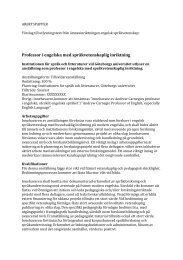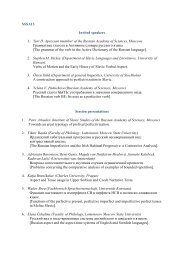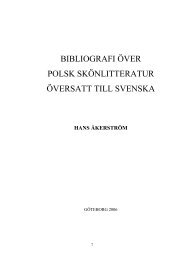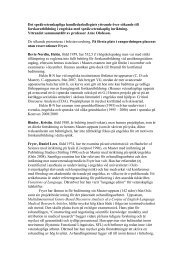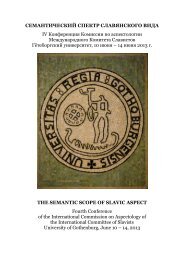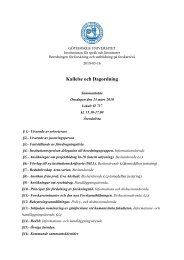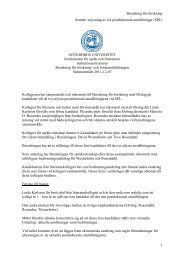<strong>Cultural</strong> Translation between Traditions,Languages and ImagesFocusing on The Whale RiderNanyan Guo 郭 南 燕International Research Center for Japanese StudiesAbstractIn this presentation, I will first try to define several key words based on previous research,such as, ‘culture’, ‘translation’, ‘cultural translation’ and ‘cultural hybridity’. I will look at why theconcept of ‘cultural translation’ is useful when we want to make sense of the things we are not familiarwith, either within our society or from different societies. Then I will examine a renownedNew Zealand novella The Whale Rider (1987), which is a mixture of Maori mythology, fiction andcontemporary Maori life style. Finally, I will see how ‘cultural translation’ takes place inside thestory, between the literary text and the film adaptation (2002), and in the Japanese (2003) andChinese versions (2006) of the novella.The Whale Rider was written by Witi Ihimaera, a New Zealander with Maori and Europeanbackgrounds. In the novella, the heroin, a young girl, faces her great-grandfather’s discriminationwho believes that women cannot lead the Maori people. Eventually the heroin proves her capabilityby riding the whale king. The novella raises several issues: how the so-called Maori traditionsshould adapt to modern times; how the conflicts between men and women need to be resolved;and how the natural environment must be protected for the Maori and whales to survive.I will concentrate on several aspects of the novella and the film where ‘cultural translation’takes place: 1) the difference in interpreting ‘authentic’ Maori leadership by the old generationand the new, and by men and women, 2) the difference in interpreting the role of whalesin Maori society by the people and by whales themselves, 3) the transformation from discardedtraditions to a newly unified community, 4) the limits in understanding and the possibility ofmisunderstanding ome Maori concepts, and 5) cultural hybridization in the novella, the film andthe Japanese and Chinese versions.11
12Introduction‘<strong>Cultural</strong> Translation’ is a term which has been frequently used recently. In a broad sense, thisterm is considered to refer to the common practices in most societies from the beginning of humanhistory and cultural formation.In this paper, I will first look at several representative definitions of the words ‘culture’, ‘language’,‘translation’ and ‘cultural translation’ which are to be used often here. Second, I will focuson a renowned New Zealand novella The Whale Rider (1987) whose content displays typicalexamples of ‘cultural translation.’ Third, I will move to its Japanese (2003) and Chinese (2006)translations to see how ‘culture translation’ takes place between different languages and cultures.Fourth, I will analyze how images can or cannot be translated. Finally I will discuss whythe term ‘cultural translation’ is useful in analyzing literary translations involving different languages,as well as in observation of social contacts between different cultures in today’s world.Culture, Language, TranslationThe most classical definition of ‘culture’ was made by Edward B. Tylor in 1865. ‘Culture or civilization,taken in its wide ethnographic sense, is that complex whole which includes knowledge,belief, art, morals, law, customs and any other capabilities and habits acquired by man as a memberof society’ (Tylor, 1865, 1871) 1 . Since then the term ‘complex whole’ has been often used todescribe ‘culture’.Tracing the development of the concept of ‘culture’, Raymond Williams, pointed out in 1958that ‘culture’ originally meant ‘tending of natural growth’, and then a ‘process of human training.’It was always ‘a culture of something’. But in the 18 th century and the early 19 th century, it became‘a thing in itself.’ He continued to say,It came to mean, first, ‘a general state of habit of the mind’, having close relations with theidea of human perfection. Second, it came to mean ‘the general state of intellectual development,in a society as a whole’. Third, it came to mean ‘the general body of the arts’. Fourth, later in thecentury, it came to mean ‘a whole way of life, material, intellectual and spiritual” (Williams,1958) 2Analyzing the functions of ‘culture’, Malinowski pointed out in 1944 that ‘culture’ is ‘the integralwhole consisting of implements and consumers’ goods, of constitutional charters for thevarious social groupings, of human ideas and crafts, beliefs and customs.’ 3 Meanwhile, he paid attentionto the fact that culture is constantly under pressure for change. ‘A cultural standard of living…meansthat new needs appear and new imperatives or determinants are imposed on humanbehaviour. Clearly, cultural tradition has to be transmitted from each generation to the next.’ 41 Tylor, Edward, (1865) 1870, Primitive Culture: Researches into the Development of Mythology, Philosophy,Religion, Language, Art, and Custom. Vol. 1, 1870 edition, London: John Murray, Albemarle Street, p.1.2 Williams, Raymond, (1958) 1983, Culture and Society, 1780-1950. New York: Columbia University Press,reissued 1971, p.163 Malinowski, Bronislaw, (1944) 1979, A Scientific Theory of Culture and Other Essays, Chapel Hill: theUniversity of North Caroline Press, 9 th printing, 1979, p.36.4 Malinowski, Bronislaw, (1944) 1979, A Scientific Theory of Culture and Other Essays, Chapel Hill: theUniversity of North Caroline Press, 9 th printing, 1979, p.37.Nanyan Guo
- Page 1: Cultural TranslationsProceedings of
- Page 4 and 5: PrefaceThe idea of organizing a wor
- Page 6 and 7: ContentsAcknowledgementIIPrefaceIII
- Page 8 and 9: Literature and Transculturality:Som
- Page 10 and 11: agenda of Herder, which was to figh
- Page 12 and 13: nomenon. However, until long into t
- Page 14 and 15: Tawada’s work appeared in Swedish
- Page 16 and 17: multiple interpretations. Japan is
- Page 20 and 21: George P. Murdock illustrated the p
- Page 22 and 23: ancestor of the Maori arrived in Ao
- Page 24 and 25: nal names do not necessarily have.
- Page 26 and 27: One of the functions of ‘cultural
- Page 28 and 29: PRELUDEIn 2003, an original artisti
- Page 30 and 31: planted, adopted and fused with ind
- Page 32 and 33: liest known written clues regarding
- Page 34 and 35: since there are many Asians and Pac
- Page 36 and 37: listening to and evaluating sounds
- Page 38 and 39: Ensemble, and the Moscow Pan-Asian
- Page 40 and 41: temporary Finnish folk music. 29I a
- Page 42 and 43: Although some space for improvisati
- Page 44 and 45: whom have devoted many years to ser
- Page 46: POSTLUDEBy way of conclusion, allow
- Page 49 and 50: IntroductionThe aim of this paper i
- Page 51 and 52: to discuss what role Japan was to p
- Page 53 and 54: I may be allowed henceforth to use
- Page 55 and 56: program was to promote and help stu
- Page 57 and 58: 50different of that of Millán -Ast
- Page 59 and 60: most impracticable people in the ea
- Page 61 and 62: intending to give the Book a quasi
- Page 63 and 64: understood by the West on a time wh
- Page 65 and 66: FUJIWARA Masahiko. (2008) Kokka no
- Page 67: - (2002) Cultural light, political
- Page 70 and 71:
Translation, or better, linguistic
- Page 72 and 73:
one may not expect anything other t
- Page 74 and 75:
as Murakami opts for a globalized v
- Page 76 and 77:
market. 17 Another indispensable to
- Page 78 and 79:
(This is part of my doctoral thesis
- Page 80 and 81:
elieve advances man’s progress he
- Page 82 and 83:
ender the New Testament into Japane
- Page 84 and 85:
a synonym for kami. The latter is a
- Page 86 and 87:
The American school text is in the
- Page 88 and 89:
Willson Reader 46 T73 47I will not
- Page 90 and 91:
Gentlzer, Edwin & Tymoczko, Maria 2
- Page 92 and 93:
Tea ceremony or tea cult?Translatin
- Page 94 and 95:
Company (VOC), men came from differ
- Page 96 and 97:
H. Stolpe gathered items in Japan f
- Page 98 and 99:
simple presentations had negative i
- Page 100 and 101:
theticism, with its manifold bearin
- Page 102 and 103:
Kumakura, Isao (1980) 近 代 茶
- Page 104 and 105:
1. Introduction and aim of the pape
- Page 106 and 107:
main character and the caller doesn
- Page 108 and 109:
not” and ”at present” that ha
- Page 110 and 111:
match this name, a sea as artificia
- Page 112 and 113:
I John Gabriel BorkmanHenrik Ibsen
- Page 114 and 115:
his dream during the 1870s, when ca
- Page 116 and 117:
make a decision. But it turns out t
- Page 118 and 119:
Ôgai’s change of translation str
- Page 120 and 121:
Behind every utterance lies two mot
- Page 122 and 123:
a large group of persons be gathere
- Page 124 and 125:
The “Territory of Translation”
- Page 126 and 127:
八 十 日 間 世 界 一 周 :
- Page 128 and 129:
heuristic tools, especially conside
- Page 130 and 131:
Left: Photo of Kawashima Chūnosuke
- Page 132 and 133:
Burlington Gardens is in London (Ro
- Page 134 and 135:
門 アリ 入 リテ 見 レバ
- Page 136 and 137:
scene seems to be merely one of man
- Page 138 and 139:
Niwa Jun’ichirō’s Spring Tale
- Page 140 and 141:
The text is full of detailed descri
- Page 142 and 143:
where the narrative voice does not
- Page 144 and 145:
The reason the “territory of tran
- Page 146 and 147:
Translating the Trip Around the Wor
- Page 148 and 149:
ForwordI have been working on my do
- Page 150 and 151:
clining though. By the end of 1980
- Page 152 and 153:
幸 い 神 の 怒 りは 鎮 ま
- Page 154 and 155:
The Public Sphere as Deliberation o
- Page 156 and 157:
and absence of hierarchy would have
- Page 158 and 159:
was used much like we would use “
- Page 160 and 161:
outcasts and bandits - were suppose
- Page 162 and 163:
cal sense, the arena where particip
- Page 164 and 165:
society” and in which “there wa
- Page 166 and 167:
sic formulations, the public sphere
- Page 168 and 169:
はじめに日 本 統 治 下 の
- Page 170 and 171:
似 地 一 下 一 下 拽 那 鼻
- Page 172 and 173:
ということから、 古 丁
- Page 174 and 175:
の「 序 」で、 大 東 亜
- Page 176 and 177:
3.1 翻 訳 と 満 洲 国 語 政
- Page 178 and 179:
取 り 入 れを 主 張 する
- Page 180 and 181:
文 化 の 翻 訳 としての「
- Page 182 and 183:
史 性 にも 留 意 すべきだ
- Page 184 and 185:
て、 渦 巻 きよりほかは
- Page 186 and 187:
変 わらないということも
- Page 188 and 189:
訳 語 と 新 語 から 見 る
- Page 190 and 191:
しは「 無 為 」や「 本 性
- Page 192 and 193:
思 想 を 基 礎 として、
- Page 194 and 195:
って「 物 理 上 哲 学 」
- Page 196 and 197:
し、まさにはこの 時 期
- Page 198 and 199:
意 譯 : 理 學 、 性傅 汛
- Page 200 and 201:
柴 田 昌『 增 補 訂 正 英
- Page 202 and 203:
一 八 七 七 年 、 文 部 省
- Page 204 and 205:
日 中 友 好 の 象 徴 「 鑑
- Page 206 and 207:
と 指 摘 した。成 吉 思
- Page 208 and 209:
をあげている。さらにま
- Page 210 and 211:
に 請 ひて 出 家 を 求 む
- Page 212 and 213:
この 時 奉 請 の 十 師 等
- Page 214 and 215:
歴 史 小 説 『 天 平 の 甍
- Page 216 and 217:
点 」が 生 じたと 指 摘
- Page 218 and 219:
まず、 昨 今 、 活 発 に
- Page 220 and 221:
2、 従 来 の 比 較 文 学 (c
- Page 222 and 223:
普 遍 理 論 を 適 用 し、
- Page 224 and 225:
ス・テグネル(Esaias Tegnér,
- Page 226 and 227:
に 満 ちる「 生 命 」に
- Page 228 and 229:
う 形 をとって 展 開 した
- Page 230:
学 が 大 学 で 展 開 して



